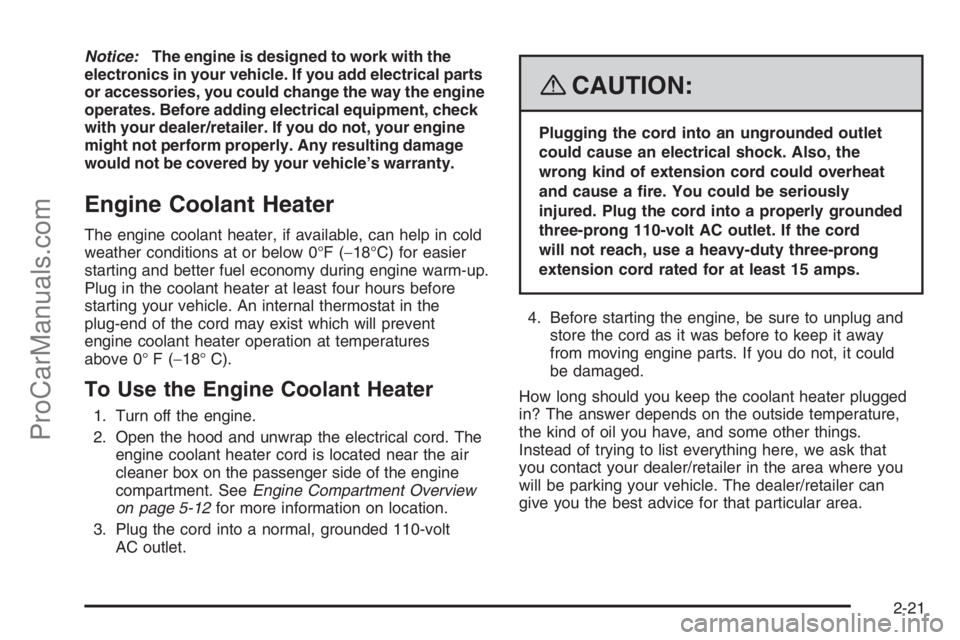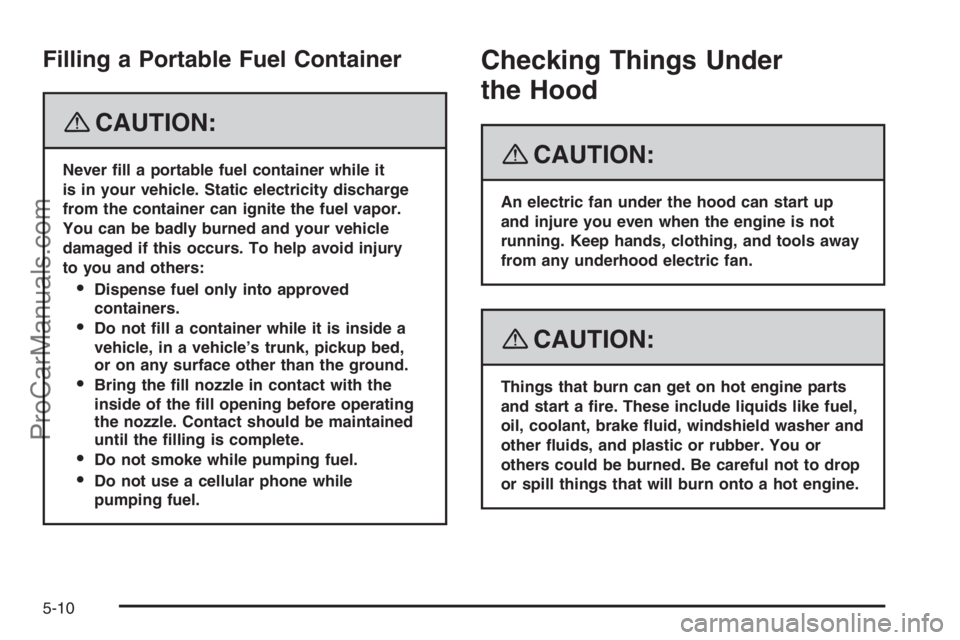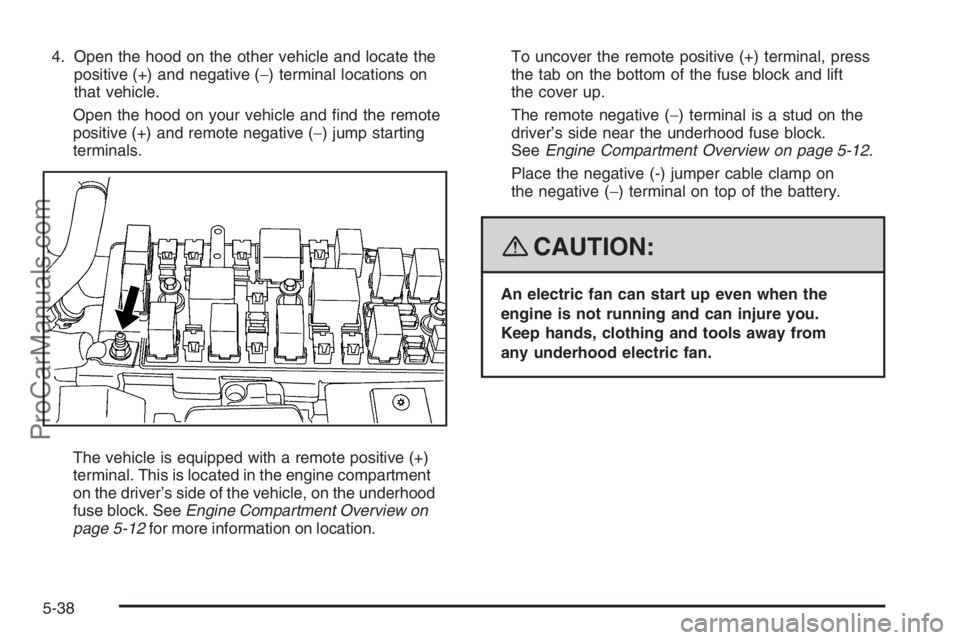hood open SATURN VUE 2008 Owners Manual
[x] Cancel search | Manufacturer: SATURN, Model Year: 2008, Model line: VUE, Model: SATURN VUE 2008Pages: 412, PDF Size: 2.78 MB
Page 93 of 412

To arm the theft-deterrent system, press the lock button
on the RKE transmitter when all doors and the hood
(vehicles started with the remote start feature only)
are closed. The security light will come on solid
for approximately 30 seconds and then �ashes slowly.
If the lock button on the RKE transmitter is pressed
a second time, the theft-deterrent system will activate
immediately, bypassing the 30 second delay. The
content theft deterrent alarm is not armed until the
security light �ashes slowly.
If any door, liftgate or the hood (vehicles started with
the remote start feature only) are opened without using
the key or pressing the unlock button on the RKE
transmitter, the exterior lamps �ash and the horn will
sound for about 30 seconds. If the lock or unlock
button on the RKE transmitter is not pressed, the alarm
sounds and periodically repeats. If the system does
not operate as described above, see your dealer/retailer
for service.
The theft-deterrent system also activates if you lock
the doors with a key.
To avoid setting off the alarm by accident, always
unlock a door with the RKE transmitter or a key.
Unlocking a door any other way will set off the
alarm if the system has been armed.If you set off the alarm by accident, turn off the alarm
by pressing lock or unlock on the RKE transmitter or by
placing the key in the ignition and turning it to START.
Testing the Alarm
To test the alarm:
1. From inside the vehicle, lower the driver’s window
and open the driver’s door.
2. Get out of the vehicle, close the door and activate
the system by locking the doors with the RKE
transmitter.
3. Wait for the security light to �ash slowly.
4. Then reach in through the window, unlock the
door with the manual door lock and open the
door. This should set off the alarm.
If the alarm does not sound when it should, but the
vehicle’s headlamps �ash, check to see if the horn
works. The horn fuse may be blown. To replace the
fuse, seeFuses and Circuit Breakers on page 5-97.
If the alarm does not sound or the vehicle’s headlamps
do not �ash, see your dealer/retailer for service.
2-15
ProCarManuals.com
Page 99 of 412

Notice:The engine is designed to work with the
electronics in your vehicle. If you add electrical parts
or accessories, you could change the way the engine
operates. Before adding electrical equipment, check
with your dealer/retailer. If you do not, your engine
might not perform properly. Any resulting damage
would not be covered by your vehicle’s warranty.
Engine Coolant Heater
The engine coolant heater, if available, can help in cold
weather conditions at or below 0°F (−18°C) for easier
starting and better fuel economy during engine warm-up.
Plug in the coolant heater at least four hours before
starting your vehicle. An internal thermostat in the
plug-end of the cord may exist which will prevent
engine coolant heater operation at temperatures
above 0° F (−18° C).
To Use the Engine Coolant Heater
1. Turn off the engine.
2. Open the hood and unwrap the electrical cord. The
engine coolant heater cord is located near the air
cleaner box on the passenger side of the engine
compartment. SeeEngine Compartment Overview
on page 5-12for more information on location.
3. Plug the cord into a normal, grounded 110-volt
AC outlet.
{CAUTION:
Plugging the cord into an ungrounded outlet
could cause an electrical shock. Also, the
wrong kind of extension cord could overheat
and cause a �re. You could be seriously
injured. Plug the cord into a properly grounded
three-prong 110-volt AC outlet. If the cord
will not reach, use a heavy-duty three-prong
extension cord rated for at least 15 amps.
4. Before starting the engine, be sure to unplug and
store the cord as it was before to keep it away
from moving engine parts. If you do not, it could
be damaged.
How long should you keep the coolant heater plugged
in? The answer depends on the outside temperature,
the kind of oil you have, and some other things.
Instead of trying to list everything here, we ask that
you contact your dealer/retailer in the area where you
will be parking your vehicle. The dealer/retailer can
give you the best advice for that particular area.
2-21
ProCarManuals.com
Page 260 of 412

Gasoline Octane
If your vehicle has the 2.4L L4 engine (VIN Code P) or
the 3.5L V6 engine (VIN Code N), use regular unleaded
gasoline with a posted octane rating of 87 or higher. If the
octane rating is less than 87, you might notice an audible
knocking noise when you drive, commonly referred to as
spark knock. If this occurs, use a gasoline rated at 87
octane or higher as soon as possible. If you are using
gasoline rated at 87 octane or higher and you hear heavy
knocking, the engine needs service.
If your vehicle has the 3.6L V6 engine (VIN Code 7),
use regular unleaded gasoline with a posted octane
rating of 87 or higher. For best performance or trailer
towing, you could choose to use middle grade 89 octane
unleaded gasoline. If the octane rating is less than 87,
you might notice an audible knocking noise when you
drive, commonly referred to as spark knock. If this occurs,
use a gasoline rated at 87 octane or higher as soon as
possible. If you are using gasoline rated at 87 octane or
higher and you hear heavy knocking, the engine needs
service.
Gasoline Speci�cations
At a minimum, gasoline should meet ASTM speci�cation
D 4814 in the United States or CAN/CGSB-3.5 or 3.511 in
Canada. Some gasolines contain an octane-enhancing
additive called methylcyclopentadienyl manganese
tricarbonyl (MMT). We recommend against the use of
gasolines containing MMT. SeeAdditives on page 5-7
for additional information.
California Fuel
If your vehicle is certi�ed to meet California Emissions
Standards, it is designed to operate on fuels that
meet California speci�cations. See the underhood
emission control label. If this fuel is not available
in states adopting California emissions standards,
your vehicle will operate satisfactorily on fuels meeting
federal speci�cations, but emission control system
performance might be affected. The malfunction
indicator lamp could turn on and your vehicle might
fail a smog-check test. SeeMalfunction Indicator Lamp
on page 3-41. If this occurs, return to your authorized
dealer/retailer for diagnosis. If it is determined that
the condition is caused by the type of fuel used,
repairs might not be covered by the vehicle warranty.
5-6
ProCarManuals.com
Page 264 of 412

Filling a Portable Fuel Container
{CAUTION:
Never �ll a portable fuel container while it
is in your vehicle. Static electricity discharge
from the container can ignite the fuel vapor.
You can be badly burned and your vehicle
damaged if this occurs. To help avoid injury
to you and others:
Dispense fuel only into approved
containers.
Do not �ll a container while it is inside a
vehicle, in a vehicle’s trunk, pickup bed,
or on any surface other than the ground.
Bring the �ll nozzle in contact with the
inside of the �ll opening before operating
the nozzle. Contact should be maintained
until the �lling is complete.
Do not smoke while pumping fuel.
Do not use a cellular phone while
pumping fuel.
Checking Things Under
the Hood
{CAUTION:
An electric fan under the hood can start up
and injure you even when the engine is not
running. Keep hands, clothing, and tools away
from any underhood electric fan.
{CAUTION:
Things that burn can get on hot engine parts
and start a �re. These include liquids like fuel,
oil, coolant, brake �uid, windshield washer and
other �uids, and plastic or rubber. You or
others could be burned. Be careful not to drop
or spill things that will burn onto a hot engine.
5-10
ProCarManuals.com
Page 265 of 412

Hood Release
To open the hood, do the following:
1. Pull the handle with
this symbol on it. It is
located under the
instrument panel on
the driver side of
the vehicle.
2. Then go to the front of the vehicle and lift up on the
secondary hood release lever.
3. Lift the hood.
Before closing the hood, be sure all the �ller caps are
on properly. Then pull the hood down and close it �rmly.
5-11
ProCarManuals.com
Page 266 of 412

Engine Compartment Overview
When you open the hood on the 2.4L L4 engine, you will see the following:
5-12
ProCarManuals.com
Page 268 of 412

When you open the hood on the 3.5L V6 engine (3.6L V6 similar), you will see the following:
5-14
ProCarManuals.com
Page 279 of 412

{CAUTION:
You can be burned if you spill coolant on hot
engine parts. Coolant contains ethylene glycol,
and it will burn if the engine parts are hot
enough. Do not spill coolant on a hot engine.
When replacing the pressure cap, make sure it is
hand-tight and fully seated.
Coolant Surge Tank Pressure Cap
Notice:If the pressure cap is not tightly installed,
coolant loss and possible engine damage may
occur. Be sure the cap is properly and tightly
secured.
If you need to replace your coolant surge tank pressure
cap, see your retailer.
Engine Overheating
There is a coolant temperature warning light on your
vehicle’s instrument panel. SeeEngine Coolant
Temperature Warning Light on page 3-40.
If Steam Is Coming From Your Engine
{CAUTION:
Steam from an overheated engine can burn
you badly, even if you just open the hood.
Stay away from the engine if you see or hear
steam coming from it. Just turn it off and get
everyone away from the vehicle until it cools
down. Wait until there is no sign of steam or
coolant before you open the hood.
If you keep driving when your engine is
overheated, the liquids in it can catch �re.
You or others could be badly burned. Stop
your engine if it overheats, and get out of the
vehicle until the engine is cool.
Notice:If your engine catches �re because you
keep driving with no coolant, your vehicle can
be badly damaged. The costly repairs would not
be covered by your warranty.
5-25
ProCarManuals.com
Page 280 of 412

If No Steam Is Coming From Your
Engine
If you get an engine overheat warning, but see or
hear no steam, the problem may not be too serious.
Sometimes the engine can get a little too hot when you:
Climb a long hill on a hot day.
Stop after high-speed driving.
Idle for long periods in traffic.
Tow a trailer.
If you get the overheat warning with no sign of steam,
try this for a minute or so:
1. If you have an air conditioner and it is on, turn it off.
2. Turn on your heater to full hot at the highest fan
speed and open the windows as necessary.
3. Try to minimize engine load. If you are in a traffic
jam, shift to NEUTRAL (N); otherwise, shift to the
highest gear possible while driving.If you no longer have the overheat warning, you can
drive. Just to be safe, drive slower for about ten minutes.
If the warning does not come back on, you can drive
normally.
If the warning continues and you have not stopped, pull
over, stop, and park your vehicle right away.
If there is still no sign of steam, idle the engine for
three minutes while you are parked. If the warning
continues, turn off the engine and get everyone out of
the vehicle until it cools down.
You may decide not to lift the hood but to get service
help right away.
5-26
ProCarManuals.com
Page 292 of 412

4. Open the hood on the other vehicle and locate the
positive (+) and negative (−) terminal locations on
that vehicle.
Open the hood on your vehicle and �nd the remote
positive (+) and remote negative (−) jump starting
terminals.
The vehicle is equipped with a remote positive (+)
terminal. This is located in the engine compartment
on the driver’s side of the vehicle, on the underhood
fuse block. SeeEngine Compartment Overview on
page 5-12for more information on location.To uncover the remote positive (+) terminal, press
the tab on the bottom of the fuse block and lift
the cover up.
The remote negative (−) terminal is a stud on the
driver’s side near the underhood fuse block.
SeeEngine Compartment Overview on page 5-12.
Place the negative (-) jumper cable clamp on
the negative (−) terminal on top of the battery.
{CAUTION:
An electric fan can start up even when the
engine is not running and can injure you.
Keep hands, clothing and tools away from
any underhood electric fan.
5-38
ProCarManuals.com